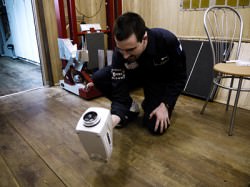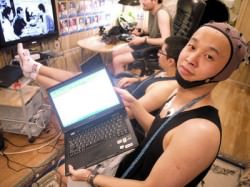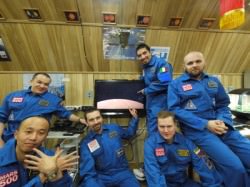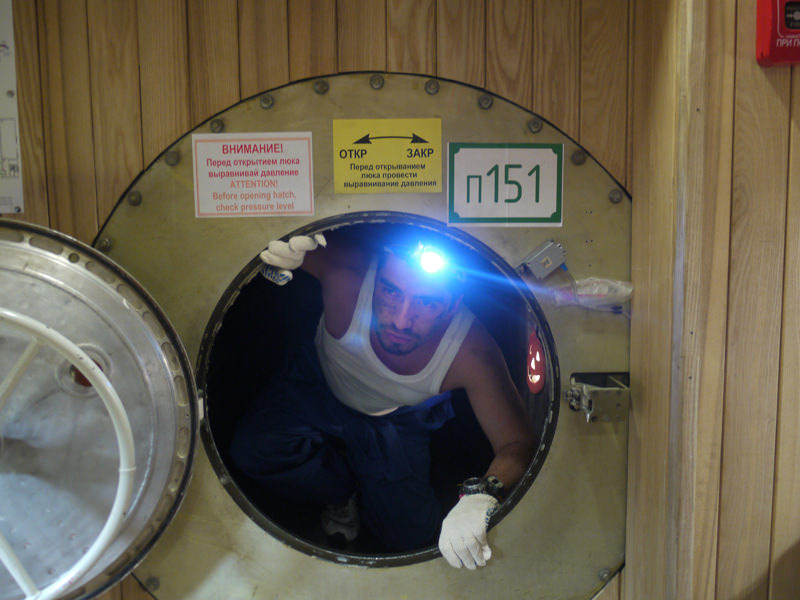[/caption]
With less than 48 hours left to go – and after 520 days – the Mars500 crew will officially “open the hatch” on their isolation on November 4. Scientists are eagerly awaiting the last of the experiments, but the inside team is awaiting freedom. They’ve been there since June of last year!
It’s been 17 long months filled with countless hours of experiments. During this simulated Mars mission, these gents have had their brains monitored, bodies scanned, donated samples and kept house. On top of that, they’ve done it so well that scientists can’t wait to get their hands on the results. The most important question of all has already been answered.
And the answer is “Yes.”

Can you imagine what would almost seem like purgatory? Even the most dedicated of us get days off, and knowing you truly aren’t in space would be a difficult hurdle to overcome. “They have had their ups and downs, but these were to be expected. In fact, we anticipated many more problems, but the crew has been doing surprisingly well.” continues Sunblad. “August was the mental low point: it was the most monotonous phase of the mission, their friends and families were on vacation and didn’t send so many messages, and there was also little variation in food.”
However, things didn’t stay bleak for long. Morale returned as the end came into sight after an artificial delay and communications with friends and family began again on September 15th. “The high fidelity of the simulation has been an important factor in the success of the experiment,” notes Patrik. “Simulating a real mission to Mars as closely as is possible on Earth has been very important for the crew. Knowing this mission is really helping to make a real mission to Mars possible has made the challenging long-duration experiment somehow easier for the crew.”


Way to go, Mars500 crew! The first round is on the house…
Original Story Source: ESA News Release.


I think I’d probably cope better with the real thing than the simulation… what a depressing thought it would be (to me at least) to know that instead of making history as one of the first humans on another planet, I’d instead given up a year and a half of my life for the most minor of footnotes.
Luckily the real crew had a better outlook 😉
Then again, how is that different than grad school?
It is interesting that they only had men during this experiment. Does that mean that an actual Mars mission would only include men? I hope not. I believe that social psychology tells us that the best functioning and most productive groups are composed mostly of men, with some women, to balance out the healthy/problematic aspects of each gender’s psychology. This, of course, also depends on the individual psychologies of the people you sent – probably wouldn’t work if you sent 6 psychopaths or 6 lazy stoners to Mars. You would need to have 6 ambitious, driven people who were able to balance out their individual drives with a need to work as a team. I would hope that prior to sending the astronauts out on the mission, they would be spending a lot of time together to work through their individual dynamics so they didn’t discover well into the mission that they hated each other or were unable to work out interpersonal conflicts.
As to whether these guys are a “most minor of footnotes”, I think that they have contributed a great deal towards understanding human psychology and have taken one of the many steps needed to get people to Mars.
Having said all that, in the end the trip will never get underway in my lifetime because of world economy and funding issues. We have the technology, but not the political will or economic ability.
The group was self chosen, but perhaps there was also a choice based on the setup (sleeping facilities et cetera). Moreover the principal partner, Russia, has for some reason been reluctant to send women to space: only 3 out of ~ 100 cosmonauts.
What I hear from studies of work places, mixed sex work places are claimed to be more efficient and harmonious. I have never heard that a majority of men would be be better. Nor do I know of studies on confined localities (i.e. including private life).
As for economy of Mars trips, Musk has offered a viable, perhaps the only viable, alternative: lowering LEO launch cost so that some ~ 8 000 people can afford and want to take the risks of colonizing Mars. I haven’t heard anything else realistically approaching that plan.
Pregnancy would be a problem. I don’t think they will allow to give birth inside the complex just for the sake of experiment. So basically they would have to cancel experiment in case of a pregnancy.
I think both ways have their ups and downs. However, your standard work environment is a daily temporary situation. At the end of the day you go home.
If you got a mix group of men and women stuck together for a year and a half, well…that can bring some interesting problems depending on romantic circumstances. This is both on the trip as well as during the trip at home. Shouldn’t be a need to elaborate further as we commonly see the same problems on Earth even without the isloation and forced cohabitation.
Don’t get me wrong, I think they should send whoever is best qualified with no regards to race, gender, etc.
Anyway…
I’m curious to know if the entire ‘capsule’ is made of the wood shown in all the photos. I would think that would impact the test results as the wood would be a more comforting environment than what they would have in a real capsule…which would probably feel like being locked in a hospital room.
I didn’t think the experiment was possible, so I am greatly encouraged. Kudos to the “marstronauts” and, yes, the beer is waiting!